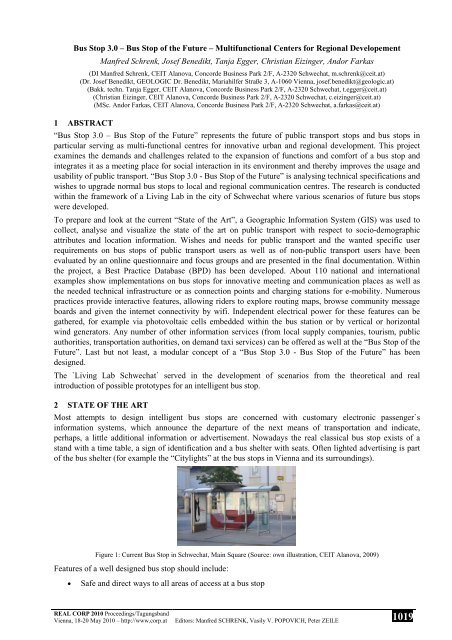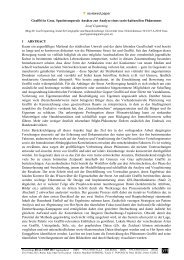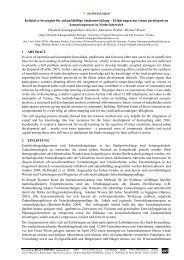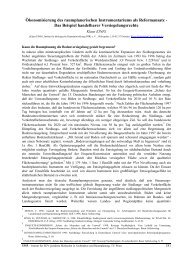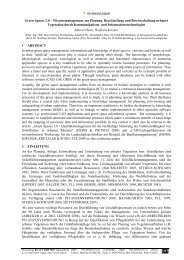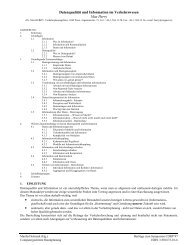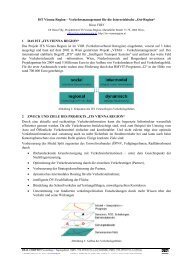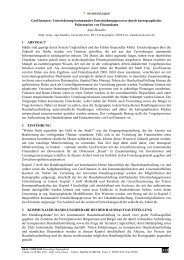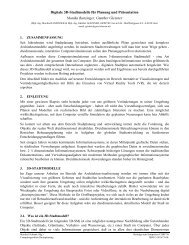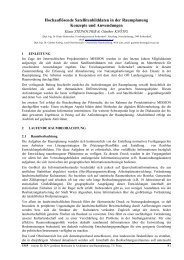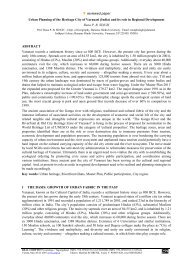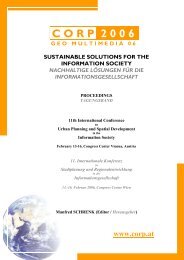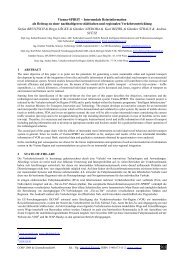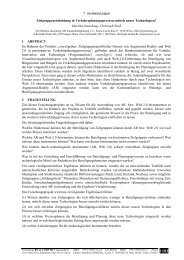Bus Stop 3.0 – Bus Stop of the Future – Multifunctional ... - CORP
Bus Stop 3.0 – Bus Stop of the Future – Multifunctional ... - CORP
Bus Stop 3.0 – Bus Stop of the Future – Multifunctional ... - CORP
Create successful ePaper yourself
Turn your PDF publications into a flip-book with our unique Google optimized e-Paper software.
<strong>Bus</strong> <strong>Stop</strong> <strong>3.0</strong> <strong>–</strong> <strong>Bus</strong> <strong>Stop</strong> <strong>of</strong> <strong>the</strong> <strong>Future</strong> <strong>–</strong> <strong>Multifunctional</strong> Centers for Regional Developement<br />
Manfred Schrenk, Josef Benedikt, Tanja Egger, Christian Eizinger, Andor Farkas<br />
(DI Manfred Schrenk, CEIT Alanova, Concorde <strong>Bus</strong>iness Park 2/F, A-2320 Schwechat, m.schrenk@ceit.at)<br />
(Dr. Josef Benedikt, GEOLOGIC Dr. Benedikt, Mariahilfer Straße 3, A-1060 Vienna, josef.benedikt@geologic.at)<br />
(Bakk. techn. Tanja Egger, CEIT Alanova, Concorde <strong>Bus</strong>iness Park 2/F, A-2320 Schwechat, t.egger@ceit.at)<br />
(Christian Eizinger, CEIT Alanova, Concorde <strong>Bus</strong>iness Park 2/F, A-2320 Schwechat, c.eizinger@ceit.at)<br />
(MSc. Andor Farkas, CEIT Alanova, Concorde <strong>Bus</strong>iness Park 2/F, A-2320 Schwechat, a.farkas@ceit.at)<br />
1 ABSTRACT<br />
“<strong>Bus</strong> <strong>Stop</strong> <strong>3.0</strong> <strong>–</strong> <strong>Bus</strong> <strong>Stop</strong> <strong>of</strong> <strong>the</strong> <strong>Future</strong>” represents <strong>the</strong> future <strong>of</strong> public transport stops and bus stops in<br />
particular serving as multi-functional centres for innovative urban and regional development. This project<br />
examines <strong>the</strong> demands and challenges related to <strong>the</strong> expansion <strong>of</strong> functions and comfort <strong>of</strong> a bus stop and<br />
integrates it as a meeting place for social interaction in its environment and <strong>the</strong>reby improves <strong>the</strong> usage and<br />
usability <strong>of</strong> public transport. “<strong>Bus</strong> <strong>Stop</strong> <strong>3.0</strong> - <strong>Bus</strong> <strong>Stop</strong> <strong>of</strong> <strong>the</strong> <strong>Future</strong>” is analysing technical specifications and<br />
wishes to upgrade normal bus stops to local and regional communication centres. The research is conducted<br />
within <strong>the</strong> framework <strong>of</strong> a Living Lab in <strong>the</strong> city <strong>of</strong> Schwechat where various scenarios <strong>of</strong> future bus stops<br />
were developed.<br />
To prepare and look at <strong>the</strong> current “State <strong>of</strong> <strong>the</strong> Art”, a Geographic Information System (GIS) was used to<br />
collect, analyse and visualize <strong>the</strong> state <strong>of</strong> <strong>the</strong> art on public transport with respect to socio-demographic<br />
attributes and location information. Wishes and needs for public transport and <strong>the</strong> wanted specific user<br />
requirements on bus stops <strong>of</strong> public transport users as well as <strong>of</strong> non-public transport users have been<br />
evaluated by an online questionnaire and focus groups and are presented in <strong>the</strong> final documentation. Within<br />
<strong>the</strong> project, a Best Practice Database (BPD) has been developed. About 110 national and international<br />
examples show implementations on bus stops for innovative meeting and communication places as well as<br />
<strong>the</strong> needed technical infrastructure or as connection points and charging stations for e-mobility. Numerous<br />
practices provide interactive features, allowing riders to explore routing maps, browse community message<br />
boards and given <strong>the</strong> internet connectivity by wifi. Independent electrical power for <strong>the</strong>se features can be<br />
ga<strong>the</strong>red, for example via photovoltaic cells embedded within <strong>the</strong> bus station or by vertical or horizontal<br />
wind generators. Any number <strong>of</strong> o<strong>the</strong>r information services (from local supply companies, tourism, public<br />
authorities, transportation authorities, on demand taxi services) can be <strong>of</strong>fered as well at <strong>the</strong> “<strong>Bus</strong> <strong>Stop</strong> <strong>of</strong> <strong>the</strong><br />
<strong>Future</strong>”. Last but not least, a modular concept <strong>of</strong> a “<strong>Bus</strong> <strong>Stop</strong> <strong>3.0</strong> - <strong>Bus</strong> <strong>Stop</strong> <strong>of</strong> <strong>the</strong> <strong>Future</strong>” has been<br />
designed.<br />
The `Living Lab Schwechat` served in <strong>the</strong> development <strong>of</strong> scenarios from <strong>the</strong> <strong>the</strong>oretical and real<br />
introduction <strong>of</strong> possible prototypes for an intelligent bus stop.<br />
2 STATE OF THE ART<br />
Most attempts to design intelligent bus stops are concerned with customary electronic passenger`s<br />
information systems, which announce <strong>the</strong> departure <strong>of</strong> <strong>the</strong> next means <strong>of</strong> transportation and indicate,<br />
perhaps, a little additional information or advertisement. Nowadays <strong>the</strong> real classical bus stop exists <strong>of</strong> a<br />
stand with a time table, a sign <strong>of</strong> identification and a bus shelter with seats. Often lighted advertising is part<br />
<strong>of</strong> <strong>the</strong> bus shelter (for example <strong>the</strong> “Citylights” at <strong>the</strong> bus stops in Vienna and its surroundings).<br />
Figure 1: Current <strong>Bus</strong> <strong>Stop</strong> in Schwechat, Main Square (Source: own illustration, CEIT Alanova, 2009)<br />
Features <strong>of</strong> a well designed bus stop should include:<br />
• Safe and direct ways to all areas <strong>of</strong> access at a bus stop<br />
REAL <strong>CORP</strong> 2010 Proceedings/Tagungsband<br />
Vienna, 18-20 May 2010 <strong>–</strong> http://www.corp.at<br />
Editors: Manfred SCHRENK, Vasily V. POPOVICH, Peter ZEILE<br />
1019
<strong>Bus</strong> <strong>Stop</strong> <strong>3.0</strong> <strong>–</strong> <strong>Bus</strong> <strong>Stop</strong> <strong>of</strong> <strong>the</strong> <strong>Future</strong> <strong>–</strong> <strong>Multifunctional</strong> Centers for Regional Developement<br />
1020<br />
• Enough waiting area with <strong>the</strong> possibilities <strong>of</strong> sitting and/or leaning and/or take shelter<br />
• A wide range <strong>of</strong> information serving<br />
• Enough lighting<br />
• Comfortable and accessible possibililities <strong>of</strong> entrance<br />
• Guidance system for visually impaired people<br />
In cities you can find on frequently used bus stops time table displays, which show <strong>the</strong> passengers <strong>the</strong><br />
waiting time <strong>of</strong> <strong>the</strong> next bus (so called dynamical passenger information system). More statically or<br />
dynamically services are usually not available, just <strong>the</strong> opposite occurs: Many bus stops don´t have any bus<br />
shelter and/or lighting and/or seats.<br />
All <strong>of</strong> this is basically a static part <strong>of</strong> <strong>the</strong> bus stop with no ability for users to interact with <strong>the</strong> surrounding<br />
environment e.g. o<strong>the</strong>r customers, local business or communities.<br />
3 THEMATIC MAPS TO ANALYSE AND VISUALIZE INFORMATION AT “BUS STOP <strong>3.0</strong>”<br />
Geographic Information Systems (GIS) serve many purposes, among <strong>the</strong>m are to collect and store data, to<br />
analyse and visualize information. The use <strong>of</strong> GIS in “<strong>Bus</strong> <strong>Stop</strong> <strong>3.0</strong>” focuses on <strong>the</strong> analysis <strong>of</strong> <strong>the</strong> bus stop<br />
itself by (geo)locating bus stops and bus line frequencies as well as on visualizing <strong>the</strong> sociodemographic<br />
environment. Fur<strong>the</strong>rmore, a combination <strong>of</strong> qualitative (questionnaire) and quantitative (demographics) data<br />
has been employed to set <strong>the</strong> stage for future spatialization processes and <strong>the</strong>ir visualizations. For example,<br />
<strong>the</strong> questionnaire’s result on well perceived stops and not so nice ones is available for querying in an IMS<br />
environment as in <strong>the</strong> Figure 2 for Schwechat is shown below.<br />
Figure 2: Well perceived (green) and not well perceived (red) <strong>Bus</strong> <strong>Stop</strong>s (Size indicating <strong>the</strong> numbers mentioned); Results from<br />
questionnaire (Source: own illustration, Geologic Dr Benedikt, 2009)<br />
A main advantage <strong>of</strong> using a spatial information system, like a GIS in <strong>the</strong> context <strong>of</strong> “<strong>Bus</strong> <strong>Stop</strong> <strong>3.0</strong>”, is to<br />
collaboratly design and allow to research <strong>the</strong> living environment where <strong>the</strong>se bus stops lie in.<br />
In <strong>the</strong> future GIS will be developed as a Spatial Monitoring System on <strong>the</strong> effects <strong>of</strong> technological<br />
innovation on <strong>the</strong> sociodemographic environment. It will focus on tasks, like keeping track on how many<br />
families are attracted by bus stop innovations, how many companies are additionally established, what kind<br />
<strong>of</strong> technological usage is appropriate for students and etc. It is designed to allow <strong>the</strong> city’s planning<br />
institutions to closely follow <strong>the</strong> usage and development <strong>of</strong> a bus stop and it’s surroundings and eventually<br />
move bus stop locations as well as to enhance <strong>the</strong> quality <strong>of</strong> citizen participation through technologically<br />
enabled interaction at “<strong>Bus</strong> <strong>Stop</strong> <strong>3.0</strong>”.<br />
REAL <strong>CORP</strong> 2010:<br />
CITIES FOR EVERYONE. Liveable, Healthy, Prosperous
REAL <strong>CORP</strong> 2010 Proceedings/Tagungsband<br />
Vienna, 18-20 May 2010 <strong>–</strong> http://www.corp.at<br />
Manfred Schrenk, Josef Benedikt, Tanja Egger, Christian Eizinger, Andor Farkas<br />
4 WISHES AND NEEDS ABOUT A “BUS STOP OF THE FUTURE”<br />
4.1 Online Questionnaire<br />
To interact with bus stops using state <strong>of</strong> <strong>the</strong> art technology in general and mobile devices in particular is<br />
essential for a “<strong>Bus</strong> <strong>Stop</strong> <strong>3.0</strong>”. In 2009, an online questionnaire was started in spring with <strong>the</strong> duration <strong>of</strong> two<br />
months, where users and potential customers were invited to participate. Issues were set for <strong>the</strong> general use<br />
<strong>of</strong> a bus stop as well as <strong>the</strong> possible use <strong>of</strong> new technologies. 504 people answered <strong>the</strong> online questionnaire<br />
(in total 549 questionnaires including <strong>the</strong> paper questionnaire). Different web pages provided <strong>the</strong> online-link<br />
to <strong>the</strong> questionnaire (for example <strong>the</strong> webpages <strong>of</strong> BMVIT/ways2go, VOR - Verkehrsverbund Ostregion,<br />
City <strong>of</strong> Schwechat, Verein <strong>CORP</strong> <strong>–</strong> Competence Center <strong>of</strong> Urban and Regional Planning and <strong>the</strong> research<br />
institute CEIT Alanova).<br />
The poll ratings reflect <strong>the</strong> discontent with <strong>the</strong> state <strong>of</strong> <strong>the</strong> art (60% feel unpleasant waiting at a bus stop).<br />
Reasons for <strong>the</strong> discontent for example are <strong>the</strong> timeliness <strong>of</strong> <strong>the</strong> busses, less cleanliness and safety. Only 6%<br />
supported <strong>the</strong> need <strong>of</strong> technology at a bus stop. Obviously those polled could hardly imagine, that a bus stop<br />
could be more than a waiting area, where you are usually only a few minutes waiting for <strong>the</strong> bus.<br />
The questionnaire focused on different subjects to be evaluated:<br />
• Attitudes to <strong>the</strong> bus system respectively to <strong>the</strong> public transport<br />
• The usage <strong>of</strong> a bus and its needs<br />
• The usage <strong>of</strong> a bus stop and its needs<br />
• Current intensity <strong>of</strong> using Information and Communication Technology (ICT)<br />
• Attitudes <strong>of</strong> possible developments<br />
In addition to <strong>the</strong> wishes <strong>of</strong> “more seating accommodations” and “dynamical passenger information system”,<br />
also “ban <strong>of</strong> smoking”, “better wea<strong>the</strong>r protection” and “better lightning system” had been adressed. Also<br />
creative ideas, like <strong>the</strong> possibility <strong>of</strong> heating in <strong>the</strong> wintertime or cooling in <strong>the</strong> summer, were called.<br />
Figure 3: Improvement suggestions <strong>of</strong> wishes and needs at a bus stop (in %) (Source: own illustration, CEIT Alanova, 2009)<br />
The called demands are <strong>the</strong> same through <strong>the</strong> different age classes, which means <strong>the</strong> wishes are align with<br />
<strong>the</strong> improvement suggestions.<br />
4.2 Focus Groups<br />
The focus groups increased <strong>the</strong> understanding <strong>of</strong> <strong>the</strong> user requirements for <strong>the</strong> online questionnaire. The<br />
target groups and <strong>the</strong> result <strong>of</strong> <strong>the</strong>ir needs and wishes for a “<strong>Bus</strong> <strong>Stop</strong> <strong>of</strong> <strong>the</strong> <strong>Future</strong>” are:<br />
• Students: Mostly called were “seating accommodation”, “food supply”, “passenger information<br />
system”, “infoscreen” and <strong>the</strong> “availability <strong>of</strong> free internet (handy)”.<br />
• Senior citizen: Their wishes for a future bus stop were “infoscreen”, “wea<strong>the</strong>r protection” and <strong>the</strong><br />
“current dates <strong>of</strong> events in <strong>the</strong> community”.<br />
• Enterpreneurs showed a great interest in new services at bus stops, since <strong>the</strong>ir target groups can be<br />
probably reached with appropriate advertisement. At a bus stop an advertisement can be pleasant and<br />
<strong>the</strong> acceptance is higher, when waiting for <strong>the</strong> bus.<br />
Editors: Manfred SCHRENK, Vasily V. POPOVICH, Peter ZEILE<br />
1021
<strong>Bus</strong> <strong>Stop</strong> <strong>3.0</strong> <strong>–</strong> <strong>Bus</strong> <strong>Stop</strong> <strong>of</strong> <strong>the</strong> <strong>Future</strong> <strong>–</strong> <strong>Multifunctional</strong> Centers for Regional Developement<br />
The people <strong>of</strong> <strong>the</strong> focus groups were citizens or companies in <strong>the</strong> `Living Lab Schwechat`. Such a `Living<br />
Lab` allows to correspond to <strong>the</strong> knowledge <strong>of</strong> <strong>the</strong> `research citizens´ as well as <strong>the</strong>ir personal wishes,<br />
images and ideas. This was very helpful for designing a customer-friendly, future product like “<strong>Bus</strong> <strong>Stop</strong><br />
<strong>3.0</strong>”.<br />
5 NATIONAL AND INTERNATIONAL BEST PRACTICES<br />
In addition to <strong>the</strong> validation <strong>of</strong> <strong>the</strong> results <strong>of</strong> <strong>the</strong> survey and <strong>of</strong> course to discuss possible future features <strong>of</strong><br />
“<strong>Bus</strong> <strong>Stop</strong> <strong>3.0</strong>”, so called national and international Best Practices were collected and analysed and<br />
documented in a database. In that way it was possible to design a modular concept <strong>of</strong> a “<strong>Bus</strong> <strong>Stop</strong> <strong>of</strong> <strong>the</strong><br />
<strong>Future</strong>” and to create visual examples <strong>of</strong> a “<strong>Bus</strong> <strong>Stop</strong> <strong>3.0</strong>” prototype.<br />
About 110 examples <strong>of</strong> Best Practices have been collected and classified into seven different categories<br />
(design, shopping, energy supply, ICT, routing, games and accessibility). The Best Practices range from<br />
designing a concept to implement a project/prototype. Fur<strong>the</strong>rmore some features, which are not<br />
implemented at a bus stop yet, were put in <strong>the</strong> database because <strong>of</strong> relevance <strong>of</strong> “<strong>Bus</strong> <strong>Stop</strong> <strong>3.0</strong>”.<br />
With about 50 examples <strong>of</strong> Best Practices <strong>of</strong> information and communication technology (ICT) applications,<br />
ICT tools are an integral element <strong>of</strong> “<strong>Bus</strong> <strong>Stop</strong> <strong>3.0</strong>”. Because <strong>of</strong> that, such ICT applications are discussed in<br />
this paper.<br />
A variety <strong>of</strong> s<strong>of</strong>tware and hardware solutions are currently available for functions ranging from real time<br />
passenger information, internet access and digital signage to location and context based information and<br />
guidance systems for visually impaired passengers. These various applications need only be integrated to<br />
provide <strong>the</strong> functionality identified for <strong>the</strong> „<strong>Bus</strong> <strong>Stop</strong> <strong>3.0</strong>” prototype. Today’s ICT solutions are largely<br />
driven by <strong>the</strong> Internet. With this in mind, both wired and wireless solutions can be considered for delivering<br />
connectivity to “<strong>Bus</strong> <strong>Stop</strong> <strong>3.0</strong>”. However, in terms <strong>of</strong> cost and flexibility, <strong>the</strong> most promising solutions are<br />
wireless technologies including WiFi Mesh, WiMAX and LTE. These solutions can be applied in an ad hoc<br />
fashion to deliver connectivity to specific bus stops or “<strong>Bus</strong> <strong>Stop</strong> <strong>3.0</strong>” itself can become an element <strong>of</strong><br />
broader wireless initiatives including citywide wireless projects.<br />
5.1 The <strong>Bus</strong> <strong>Stop</strong> as an information point<br />
A number <strong>of</strong> cities <strong>of</strong>fer public transportation information including route planners, timetables, disruption<br />
information, real-time tracking, ticketing, etc. This information is made available at displays mounted at<br />
public transportation stops. Services such as „Quando” for Vienna, Lower Austria and Burgenland and<br />
“Scotty” bring public transportation to <strong>the</strong> Web and to <strong>the</strong> smart phones <strong>of</strong> travellers. Travel information<br />
services are also becoming available to <strong>the</strong> visually impaired. The „RAMPE Project”, for example, is an<br />
interactive, acoustic Information System for a better mobility <strong>of</strong> blind people. A number <strong>of</strong> Austrian cities<br />
(Salzburg, St. Pölten and Graz) <strong>of</strong>fer audio departure information to visually impaired by pressing a button.<br />
1022<br />
Figure 4: An interactive touch screen on <strong>the</strong> “Opera” bus stop in Paris <strong>of</strong>fers a digital map to <strong>the</strong> passengers. (Source:<br />
http://www.lepost.fr/article/2010/01/30/1915197_abri-bus-multimedia-a-l-opera-2-plus-de-details.html, 2010)<br />
Regardless <strong>of</strong> <strong>the</strong> technology, advertising can play a key role in funding <strong>the</strong> delivery <strong>of</strong> ICT services to “<strong>Bus</strong><br />
<strong>Stop</strong> <strong>3.0</strong>”. Digital signage is a fast growing medium that allows <strong>the</strong> delivery <strong>of</strong> targeted (by location, context<br />
and even demographics) ads to consumers. The signs are becoming increasing sophisticated and interactive<br />
(e.g. games, information queries, e-coupons, etc.). Beyond digital signage, <strong>the</strong> explosion in <strong>the</strong> smart phone<br />
market has led companies such as Google, Nokia, etc. to develop GPS-backed applications that can deliver<br />
advertisements, sale information, and coupons based on users’ travel history and shopping habits.<br />
REAL <strong>CORP</strong> 2010:<br />
CITIES FOR EVERYONE. Liveable, Healthy, Prosperous
REAL <strong>CORP</strong> 2010 Proceedings/Tagungsband<br />
Vienna, 18-20 May 2010 <strong>–</strong> http://www.corp.at<br />
Manfred Schrenk, Josef Benedikt, Tanja Egger, Christian Eizinger, Andor Farkas<br />
5.2 The <strong>Bus</strong> <strong>Stop</strong> as a meeting point<br />
Location-based services and <strong>the</strong> increasing number <strong>of</strong> smart phones are being combined with Web 2.0<br />
applications to create new services. Location-based social networks are arising. They allow users to share<br />
information on places, social ga<strong>the</strong>rings, music, street art and much more. Through services like Sociallight,<br />
FIND IT, Qype, Yelp, Whrrl and many more, users are leaving digital graffiti, digital sticky notes,<br />
georeferenced photos, reviews and a variety <strong>of</strong> o<strong>the</strong>r digital „crumbs” in <strong>the</strong>ir paths for <strong>the</strong>ir friends or <strong>the</strong><br />
general public to retrieve.<br />
In addition to supplying information and entertainment to passengers, ICT can help <strong>the</strong>ir experience waiting<br />
for buses to be more pleasant. CCTV monitoring can ensure <strong>the</strong>ir safety while sensors automatically manage<br />
lighting and wea<strong>the</strong>r protection at “<strong>Bus</strong> <strong>Stop</strong> <strong>3.0</strong>”.<br />
The reduction <strong>of</strong> barriers at bus stops is mostly realised through ICT and increased modern conveniences.<br />
<strong>Bus</strong> terminals, bus rapid systems (BRT) and rendez-vous bus stops are encouraging such developments. <strong>Bus</strong><br />
stops for demand (“Bedarfshaltestellen”) encourage <strong>the</strong> usage <strong>of</strong> bus stops in rural areas.<br />
5.3 The <strong>Bus</strong> <strong>Stop</strong> as a sustainable model<br />
Figure 5: Example for a <strong>Bus</strong> Rapid System in Bogota, Colombia (Source:<br />
http://www.globalurban.org/Issue1PIMag05/MagHome.htm, 2010)<br />
“<strong>Bus</strong> <strong>Stop</strong> <strong>3.0</strong>” should incorporate energy saving technologies such as LED lighting and low power ICT<br />
solutions. Moreover, <strong>the</strong> addition <strong>of</strong> renewable energy technology cannot only reduce <strong>the</strong> overall carbon<br />
footprint <strong>of</strong> <strong>the</strong> bus stop, but can also allow it to be sited in locations with limited or no external power<br />
sources. The main renewable energy sources that can be incorporated into “<strong>Bus</strong> <strong>Stop</strong> <strong>3.0</strong>’s” design are wind<br />
and solar, with <strong>the</strong> latter more suitable to most locations. However, location will be a major factor in <strong>the</strong><br />
effectiveness <strong>of</strong> such solutions in generating energy for <strong>the</strong> bus stop. The renewable energy supplying “<strong>Bus</strong><br />
<strong>Stop</strong> <strong>3.0</strong>” could be integrated into e.g. local or regional concepts <strong>of</strong> climate protection.<br />
Where conditions are favorable for renewable energy, in addition to power lighting and ICT solutions, <strong>the</strong><br />
energy can be used to allow travellers to charge <strong>the</strong>ir mobile devices while <strong>the</strong>y wait. „<strong>Bus</strong> <strong>Stop</strong> <strong>3.0</strong>” could<br />
also incorporate a charging station for an electro-scooter or -bicycle.<br />
Figure 6: The „Solar <strong>Bus</strong> <strong>Stop</strong> in Freiburg, Germany, produces 1.700 kWh/year and its electricity is fed into <strong>the</strong> grid. (Source:<br />
http://www.vag-freiburg.de/wir-ueber-uns/klimaschutz-bei-der-vag.html, 2010)<br />
Remarkable for all Best Practices is, that in urban areas <strong>the</strong>re are <strong>the</strong> most innovations at bus stops and a<br />
fur<strong>the</strong>r development in rural areas is still neglected. But in <strong>the</strong>se rural areas <strong>the</strong> project team sees a great<br />
potential for converting a bus stop into a multifunctional center (legal discussions about <strong>the</strong> needed area <strong>of</strong><br />
additional features <strong>of</strong> a bus stop could be excluded).<br />
Editors: Manfred SCHRENK, Vasily V. POPOVICH, Peter ZEILE<br />
1023
<strong>Bus</strong> <strong>Stop</strong> <strong>3.0</strong> <strong>–</strong> <strong>Bus</strong> <strong>Stop</strong> <strong>of</strong> <strong>the</strong> <strong>Future</strong> <strong>–</strong> <strong>Multifunctional</strong> Centers for Regional Developement<br />
6 THE CONCEPT OF A “BUS STOP OF THE FUTURE”<br />
Because <strong>of</strong> <strong>the</strong> evaluated needs <strong>of</strong> <strong>the</strong> user (analysis <strong>of</strong> <strong>the</strong> focus groups and questionaire) and <strong>the</strong> analysis <strong>of</strong><br />
<strong>the</strong> collected best practices a modular concept was developed. To this, different types <strong>of</strong> a “<strong>Bus</strong> <strong>Stop</strong> <strong>of</strong> <strong>the</strong><br />
<strong>Future</strong>” were designed.<br />
Basically all technologies used within <strong>the</strong> project are already available, technically possible and socially<br />
accepted. The pioneering innovation <strong>of</strong> “<strong>Bus</strong> <strong>Stop</strong> <strong>3.0</strong>” is based upon a special linking <strong>of</strong> <strong>the</strong>se technologies<br />
to support <strong>the</strong> interactivity and communication at a public transport stops to enhance social interaction in a<br />
local and regional community.<br />
From <strong>the</strong> research results <strong>of</strong> <strong>the</strong> surveys and <strong>the</strong> analysis <strong>of</strong> <strong>the</strong> Best Practices following characteristics for a<br />
“<strong>Bus</strong> <strong>Stop</strong> for <strong>the</strong> <strong>Future</strong>” this can be appointed:<br />
1024<br />
• Feature for orientation for <strong>the</strong> public transport<br />
• Feature for orientation for urban and rural areas<br />
• Place <strong>of</strong> information, communication and local supply<br />
• Meeting point<br />
• A protected, saved and convenient waiting area<br />
Based on <strong>the</strong> research results a list <strong>of</strong> technical and non-technical features <strong>of</strong> a “<strong>Bus</strong> <strong>Stop</strong> <strong>of</strong> <strong>the</strong> <strong>Future</strong>”<br />
could be drawn. The “<strong>Bus</strong> <strong>Stop</strong> <strong>3.0</strong>” prototype can be put toge<strong>the</strong>r <strong>of</strong> six modules, which are:<br />
• 1.Comfort<br />
• 2.Information<br />
• 3.Accessibility<br />
• 4.Energy<br />
• 5.Safety<br />
• 6.Service<br />
Because <strong>of</strong> <strong>the</strong> modular and flexible structure <strong>of</strong> <strong>the</strong> “<strong>Bus</strong> <strong>Stop</strong>” prototype, modifications for user-friendly<br />
and specific aplications are possible. The modules and respective <strong>the</strong> components can be easily upgraded to<br />
<strong>the</strong> actual state <strong>of</strong> <strong>the</strong> art. Such an example <strong>of</strong> a “<strong>Bus</strong> <strong>Stop</strong> <strong>of</strong> <strong>the</strong> <strong>Future</strong>” is shown in <strong>the</strong> figures below:<br />
Figure 7: „<strong>Bus</strong> <strong>Stop</strong> <strong>3.0</strong> - <strong>Bus</strong> <strong>Stop</strong> <strong>of</strong> <strong>the</strong> <strong>Future</strong>“ by day, night and bad wea<strong>the</strong>r, Schwechat, Main Square (Source: own illustration,<br />
CEIT Alanova, 2009)<br />
REAL <strong>CORP</strong> 2010:<br />
CITIES FOR EVERYONE. Liveable, Healthy, Prosperous
REAL <strong>CORP</strong> 2010 Proceedings/Tagungsband<br />
Vienna, 18-20 May 2010 <strong>–</strong> http://www.corp.at<br />
Manfred Schrenk, Josef Benedikt, Tanja Egger, Christian Eizinger, Andor Farkas<br />
Based on <strong>the</strong> state <strong>of</strong> <strong>the</strong> art (see Figure 1), <strong>the</strong> bus stop in Schwechat were visually converted to a prototype<br />
<strong>of</strong> “<strong>Bus</strong> <strong>Stop</strong> <strong>3.0</strong>” with combining five <strong>of</strong> <strong>the</strong> six modules: 1. Comfort, 2. Information, 3. Accessibility, 4.<br />
Energy and 5. Safety. Additional features range from “more seats”, “video surveillance”, “wea<strong>the</strong>r<br />
protection” and “better lightning system” to modernizations such as “dynamical passenger information<br />
service” and “digital black board”, etc.<br />
7 CONCLUSION<br />
“<strong>Bus</strong> <strong>Stop</strong> <strong>3.0</strong>” is a project aiming at <strong>the</strong> developement <strong>of</strong> a bus stop as an interactive place to communicate<br />
as well as a location for advertising <strong>of</strong> local service providers. The concepts worked within this project were<br />
focused on both: <strong>the</strong> bus stop and its integration within <strong>the</strong> surrounding living places. The use <strong>of</strong> a bus stop is<br />
not limited to exiting or entering a bus but to interact with technology, services, information and, well, o<strong>the</strong>r<br />
customers. “<strong>Bus</strong> <strong>Stop</strong> <strong>3.0</strong>” tried to escape <strong>the</strong> infinite loop <strong>of</strong> well known facts and well known resulting<br />
conclusions with regards to demographic development and technological usability. The project was<br />
supported by local politicians, decision makers, commercial institutions, public transportation authorities and<br />
<strong>the</strong> local community and schools in <strong>the</strong> City <strong>of</strong> Schwechat. An important part was played by <strong>the</strong> citizens,<br />
who participate in <strong>the</strong> project within <strong>the</strong> framework <strong>of</strong> a `Living Lab`.<br />
All results <strong>of</strong> this project-study are presented in <strong>the</strong> final documentation, that will be <strong>of</strong>fered by <strong>the</strong> Austrian<br />
Federal Ministry for Transport, Innovation and Technology (BMVIT). A mid-term aim will be <strong>the</strong><br />
involvement <strong>of</strong> <strong>the</strong> results <strong>of</strong> “<strong>Bus</strong> <strong>Stop</strong> <strong>3.0</strong>” into existing traffic concepts and to be a sustainable<br />
contribution when using public transport.<br />
8 ACKNOWLEDGMENTS<br />
The project is funded within <strong>the</strong> IV2splus programme (ways2go-initative) <strong>of</strong> <strong>the</strong> Austrian Federal Ministry<br />
for Transport, Innovation and Technology (BMVIT). The programme management lied at <strong>the</strong> Austrian<br />
Research Promotion Agency (FFG).<br />
Partners <strong>of</strong> <strong>the</strong> “<strong>Bus</strong> <strong>Stop</strong> <strong>3.0</strong>” project are “CEIT Alanova gemeinnützige GmbH”, “Geologic Dr. Benedikt”<br />
and “CEIT Raltec gemeinnützige GmbH”. The project was supported by “VOR - Verkehrsverbund Ost-<br />
Region GmbH” and <strong>the</strong> city <strong>of</strong> Schwechat (Lower Austria).<br />
9 REFERENCES<br />
AMT DER NÖ LANDESREGIERUNG: <strong>Bus</strong>haltestellen. Gruppe Raumordnung, Umwelt und Verkehr, Abteilung<br />
Gesamtverkehrsangelegenheiten: http://www.noe.gv.at/bilder/d13/<strong>Bus</strong>haltestellen.pdf (Date: January 2010)<br />
ARBEITSGRUPPE FUSSVERKEHR von SLR und FUSS e.V.: Zu Fuß zur Haltestelle. Footnote 2, Issue September 2000, p. 2,<br />
2000.<br />
BAUDOIN G., VENARD O. et al.: The RAMPE Project: Interactive, Auditive Information System for <strong>the</strong> Mobility <strong>of</strong> Blind People<br />
in Public Transports. Paper für die ITST. 2005.<br />
BUCHINGER, E.: Keynote: Innovation durch und in Netzwerke/n. Akademie der Wissenschaften. Tag der Netzwerke, 31.01.2008.<br />
ERTL G.: Verkehrskonzept <strong>–</strong> Teil 1, Blickkontakt, Wien, s.a..<br />
HÖFLER L., KOCH H.: Zukunftsfähiger und effizienter öffentlicher Verkehr für den ländlichen Raum. In: Österreichische<br />
Zeitschrift für Verkehrswissenschaft, Jg. 54, Heft 3-4, p. 13-25, 2007.<br />
MAGAUDA St., DE MARCO G., CAMERATA, F.: Innovative web-based tools for participatory planning:<br />
http://programm.corp.at/cdrom2009/papers2009/<strong>CORP</strong>2009_175.pdf (Date: January 2010)<br />
TRL Limited: The demand for public transport: a practical guide, report, p.20, s-a<br />
VAG: Solarbushaltestelle: http://www.vag-freiburg.de/wir-ueber-uns/klimaschutz-bei-der-vag.html (Date: December 2009)<br />
VCÖ <strong>–</strong> Verkehrsclub Österreich: Neue Technologien für sichere und barrierefreie Mobilität, Schriftenreihe Wissenschaft und<br />
Verkehr 1/2002, p. 19, Wien, 2002.<br />
VCÖ <strong>–</strong> Verkehrsclub Österreich: Mobilitätsberater-Handbuch, p.113, Wien, 1996.<br />
Zentrum für soziale Innovation: http://www.soziale-innovation.net/ (Date: March 2009)<br />
Editors: Manfred SCHRENK, Vasily V. POPOVICH, Peter ZEILE<br />
1025


